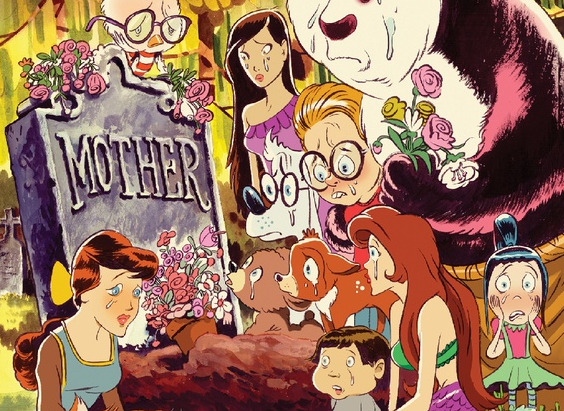
In the July/August 2014 issue of The Atlantic Sarah Boxer wonders “Why Are All the Cartoon Mothers Dead?”
And they are, you know. Bambi, Nemo, Snow White, Ariel, Belle, Pocahontas, Aladdin, and almost any other cartoon main character you can think of is a motherless child. In fact, Ms Boxer challenges her readers to “show me an animated kids’ movie that has a named mother in it who lives until the credits roll.” There aren’t that many. The Lion King, Coraline, The Incredibles and a few others come to mind.
However, she doesn’t try very hard to answer her own evocative question. She gives a few lame answers like:
- The unfolding of plot and personality depends on the dead mother.*
- The dead mother is psychologically good for the child because it allows him/her to preserve an internal good mother (even if the natural mother hadn’t been all good) and allows him/her to direct all his anger at the step mother.**
I can think of better answers than that!
As a writer, it’s obvious to me that children with living, loving parents are unlikely to be out in the cold having exciting adventures. They are at home learning how to be happy, productive members of society. And then there is the first commandment of fiction: “Torture thy Protagonist.” One of the cruelest things you can do to a child is take away his/her mother.
And as a pagan, it’s obvious to me that The Dead Mother is a metaphor for the state of modern Western Civilization. Judaism, then Christianity, and last but not least, Islam have all taken away our Mother. It was easy for them because these dominant religions of Western Civilization are all monotheistic, and each of their gods is a man. And they are all manly men, stern fathers who expect single minded devotion from their followers. In a nutshell, that’s a simplistic explanation of what happened to the Goddesses of Western Civilization.*** This link on the Goddess in Christianity and Mary Magdelene gives some quick background information on a subject that that could fill a library.****
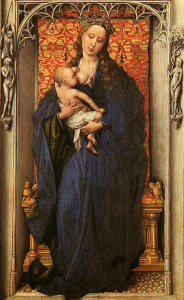 I can name only one still thriving, universally popular goddess; the exception to the Dead Mother syndrome that proves my point by illustrating how much we need our Mothers. The Blessed Virgin Mary is the goddess that the Catholic Church hasn’t managed to do away with. Of course, the Church denies up one side and down the other that she is divine, (see previous post: “The Virgin Mary, Isis, The High Priestess, and the Empress”) but you’d never know it from the way Catholics and a fair number of non-Catholics the world over worship her, and the amount of fabulous art devoted to her. When we were in Italy it seemed like every other block had carefully tended, flower bedecked BVM shrine. The Lady is definitely satisfying a strong need that the stern patriarchs of monotheism and even sweet Jesus can’t.
I can name only one still thriving, universally popular goddess; the exception to the Dead Mother syndrome that proves my point by illustrating how much we need our Mothers. The Blessed Virgin Mary is the goddess that the Catholic Church hasn’t managed to do away with. Of course, the Church denies up one side and down the other that she is divine, (see previous post: “The Virgin Mary, Isis, The High Priestess, and the Empress”) but you’d never know it from the way Catholics and a fair number of non-Catholics the world over worship her, and the amount of fabulous art devoted to her. When we were in Italy it seemed like every other block had carefully tended, flower bedecked BVM shrine. The Lady is definitely satisfying a strong need that the stern patriarchs of monotheism and even sweet Jesus can’t.
And just what is the attraction of the Mother? Well, let’s put it this way: A come to Mama moment is much more comforting and nurturing than a come to Jesus moment. Both have their place, but our lives are difficult and painful and we need comfort and understanding more often than we need the hard facts of life shoved in our face. The Goddess nourishes our emotional, intuitive, creative, and magical sides, and in a primarily God based society this doesn’t happen nearly often enough. As a result we tend to ignore our children and elders, live in emotional isolation from each other, fight wars at the drop of a helmet, pollute the earth, and value money over spirit.
There, I’m done ranting. To me it’s a no brainer. The Cartoon Mothers are dead because our culture has killed its own mother. Kill a child’s Mother and you create pain and conflict in that child’s heart. Kill the Mother in a story and you have a plot that resonates strongly with our culture.
I would have set the article aside at this point if Ms Boxer hadn’t asked a second even more intriguing question: Why have children’s movie makers not only continued to kill off the Mother, but have also replaced the wicked step mother with—ta da!—the perfect Father? To quote M
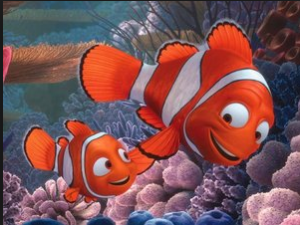
s Boxer: “He may start out hypercritical (Chicken Little) or reluctant (Ice Age). He may be a tyrant (The Little Mermaid) or a ne’er-do-well (Despicable Me). He may be of the wrong species (Kung Fu Panda). He may even be the killer of the child’s mother (Brother Bear). No matter how bad he starts out, though, he always ends up good…
Quite simply, mothers are killed in today’s kids’ movies so the fathers can take over…The old fairy-tale, family-romance movies that pitted poor motherless children against horrible vengeful stepmothers are a thing of the past. Now plucky children and their plucky fathers join forces to make their way in a motherless world. The orphan plot of yore seems to have morphed, over the past decade, into the buddy plot of today. Roll over, Freud: in a neat reversal of the Oedipus complex, the mother is killed so that the children can have the father to themselves. Sure, women and girls may come and go, even participate in the adventure, but mothers? Not allowed. And you know what? It looks like fun!”
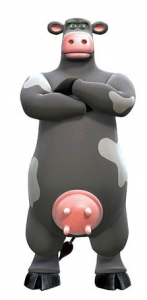 Ms Boxer goes on to suggest that this trend is a last, desperate, chauvinistic attempt to reestablish a kinder, gentler patriarchy. She is chillingly convincing. As a disturbing exhibit A she directs our attention to the movie Barnyard (Paramount/Nickelodeon, 2006), in which Ben, a father bull teaches his ne’er-do-well, motherless son, Otis, how to be a man. In this movie, when a bull stands up on his hind legs like a human, instead of the expected very Full Monty, he flashes a prominent, pink, full udder. Yes you read that right; I’ve even included a picture for your further elucidation. The message of this flick seems blatantly obvious. Who needs a mother? Men have it all.
Ms Boxer goes on to suggest that this trend is a last, desperate, chauvinistic attempt to reestablish a kinder, gentler patriarchy. She is chillingly convincing. As a disturbing exhibit A she directs our attention to the movie Barnyard (Paramount/Nickelodeon, 2006), in which Ben, a father bull teaches his ne’er-do-well, motherless son, Otis, how to be a man. In this movie, when a bull stands up on his hind legs like a human, instead of the expected very Full Monty, he flashes a prominent, pink, full udder. Yes you read that right; I’ve even included a picture for your further elucidation. The message of this flick seems blatantly obvious. Who needs a mother? Men have it all.
But this conclusion doesn’t feel right to me. I’m not ready to label Disney Studios and the rest of the children’s movie industry as male chauvinist pigs. The early Disney Movies were mostly fairy tales and fairy tales are essentially folk tales that have been told and retold. In other words they are old and probably predate Christianity. In other words, they are pagan with Christian overtones. The goddess appears in these movies in three forms, the triple goddess of modern witches. She is the maiden (usually the heroine), the mother (usually dead because the Christians killed the mother goddess) and the crone (usually the wicked witch or evil sorceress—the goddess is hard to kill completely, but easy to demonize). So the first successful children’s movies began with this formula, and Hollywood is loathe to part with a successful formula. It gets used over and over and over again. Thus we have all the dead mothers and hapless heroines and wicked female villains in children’s literature and movies. And you gotta admit, Disney had some knock-your-socks-off female villains. Definitely strong feminine role models. They are my favorite Disney characters.
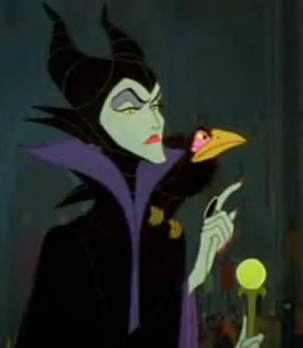
Margaret Starbird pushes this idea a bit further. (see link) She claims that Ariel, Disney’s Little Mermaid, “is much more than a fairytale for little girls. Rather, she is a powerful metaphore for the plight of the “Sacred Feminine” over the last several thousand years of western civilization.” Ariel is Mary Magdelene, the lost bride of Christianity, who has risen up from the watery depths of our subconscious and onto dry, logical land. “It is interesting to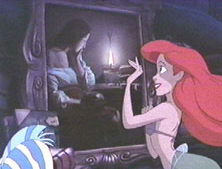 note,” says Ms Starbird, “that in the Disney film, it is not Ariel who needs to be saved, but rather it is the “handsome Prince” who is in deep trouble, shipwrecked and dying (the condition of the partriarchy at the dawn of Aquarius??)” Interesting, I thought, but she seems to be stretching it a bit. But then I came upon what for me was the clincher in her argument. Ariel collects many human artifacts and one of her special treasures is a painting. Now of all the possible works of western art Disney studios could have chosen to portray, they chose a painting by Georges de la Tour called “Magdalen with the Smoking Flame.” Perhaps there is an underlying message in The Little Mermaid after all; if so, it is distinctly feminist and definitely not patriarchal.
note,” says Ms Starbird, “that in the Disney film, it is not Ariel who needs to be saved, but rather it is the “handsome Prince” who is in deep trouble, shipwrecked and dying (the condition of the partriarchy at the dawn of Aquarius??)” Interesting, I thought, but she seems to be stretching it a bit. But then I came upon what for me was the clincher in her argument. Ariel collects many human artifacts and one of her special treasures is a painting. Now of all the possible works of western art Disney studios could have chosen to portray, they chose a painting by Georges de la Tour called “Magdalen with the Smoking Flame.” Perhaps there is an underlying message in The Little Mermaid after all; if so, it is distinctly feminist and definitely not patriarchal.
If we begin with my premise that the Mother is dead in children’s movies (and also quite a bit of Western Literature) because the Goddess was eliminated from our culture with the advent of the patriarchal monotheistic religions, we can reframe the issue of the perfect father and come to a different conclusion.
In the United States, the Goddess is alive and becoming stronger every day. According to the US Census Bureau the number of witches willing to come out of the broom closet and actually admit to being witches has increased astronomically. They estimate that in 1990 one in every 22,000 Americans was a witch, but in 2008 one in every 667 Americans was a witch, and I have no doubt that the number is even higher today. And this is only witches, not neopagans, Asatru, Hindu, Unitarian/Universalist, or other Goddess worshipping religions. Christianity still dominates our culture, but the numbers are decreasing slightly. In 1990 one in every 1.16 people said they were Christian and in 2008, the number dropped to one in every 1.32 people. This number, of course, includes Catholics who, as I have shown, actually do worship the goddess in the form of the BVM, and all the other Christians who include the Goddess in their worship in some way or other.
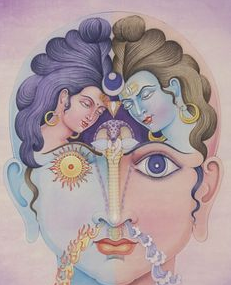 And with the popularization of Jungian psychology, the the anima, or feminine part of the male psyche, and the animus, the masculine part of the female psyche, have become household words, and the idea that men have emotions and feelings and that women have no problem being tough and logical pervades our culture.
And with the popularization of Jungian psychology, the the anima, or feminine part of the male psyche, and the animus, the masculine part of the female psyche, have become household words, and the idea that men have emotions and feelings and that women have no problem being tough and logical pervades our culture.
The film industry has been well aware of these two trends for at least the past few decades, and, I would suggest, has helped to fuel them. So why would it suddenly go all patriarchal on us? I’m not saying it hasn’t, Ms Boxer is most convincing, I’m just sayin’ that maybe, by presenting us with all these perfect fathers, the children’s film industry is encouraging men to get in touch with their inner woman, their emotional, nurturing, intuitive side and for women to get in touch with their inner man, their logical, assertive, powerful side (Yes, there are many flicks about amazingly strong women). This way our children will have not only powerful female role models, but also emotionally intact, nurturing, intuitive male role models.
The Goddess never died, she is present in each and every one of us, male and female, as is the God. What better way to bring her back into our hearts and consciousness than by presenting grieving fathers learning to be both a mother and a father to their bereft children?
What do you think? Is our film industry controlled by patriarchal misogynists or new age feminists?
*Carolyn Dever, Death and the Mother From Dickens to Freud: Victorian Fiction and the Anxiety of Origins, 1998.
**Bruno Tettleheim, The Uses of Enchantment, 1976.
***Actually, we can’t blame it all on monotheism. Paganism was turning patriarchal long before Abraham was even a gleam in his father’s eye. But at least pagans had goddesses.
****Merlin Stone, When God Was a Woman, Riane Eisler, The Chalice and the Blade, Marija Gimbutas, The Civilization of the Goddess, Monica Sjoo, The Great Cosmic Mother: Rediscovering the Religion of the Earth, Leonard Shlain, The Alphabet vs. the Goddess, and many more.


9 thoughts on “Why Are All the Cartoon Mothers Dead?”
Chrissy, one of your best blogs yet. As my friends of all genders know I’m a card carrying feminist. I *feel* you hit the nail on the head. I love me some Mary too. Thanks for extending ‘the Word’ that bit further…Goddess bless you!
Thank you thank you. I’m so glad you liked it.
Chrissy, this is ANOTHER important discussion. As the daughter of an incredibly strong, “greatest generation” mother – of whom I am incredibly proud, I saw how the impact of the loss of the goddess played out in my mother’s striving to matter in the male-dominated world of her time. (How’s that for a run-on sentence?! Sorry in a rush!)
Her times and religious teachings taught her that to be a strong woman she needed to give up her femininity and be as much like a strong male figure as possible.
This was incredibly difficult for me to understand. In my personal life, it was an unfortunate source of contention between us. I am so grateful that the tide is turning. I am happy my nieces and other young women have a much more accessible divine feminine to emulate.
Thanks again for continuing your contribution to keep us all thinking!
Namaste’
Rebecca
Yes, we are fortunate.
I believe the film industry deserves lots of credit for showing us women who are powerful yet feminine and men who are sensitive yet masculine.
Off the top of my head I can think of tales of shape-shifting women abandoning a child, or children. I’m remembering the “silkie” story in Women Who Run With the Wolves.
Fairy tales were written down during the Christian era, and probably given a churchy spin at the time. But the Grimm tales, and many others, contain ruthless characters with greedy, cruel intentions, as well as tricksters and shamanistic women disguised as “fairy godmothers.” I’m guessing they existed long before the Christian influenced printing industry was created.
I can also think of many tales in which the father was distant, dead or distracted from his childcare responsibilities, and the “fairy godmother” took over in his absence. That’s a closer metaphor for the contemporary spiritual scene, I think. Fairy godmothers rarely enter through the front door. We might not see Her coming.
“A come to Mama moment is much more comforting and nurturing than a come to Jesus moment.” Ain’t that the truth. I really enjoyed reading this. Like most people I never thought about the reason behind the stories. I hope it’s men becoming kinder and gentler, not just trying to regain power.
Me too!!!